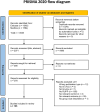Reduced uterine perfusion pressure as a model for preeclampsia and fetal growth restriction in murine: a systematic review and meta-analysis
- PMID: 38758122
- PMCID: PMC11380978
- DOI: 10.1152/ajpheart.00056.2024
Reduced uterine perfusion pressure as a model for preeclampsia and fetal growth restriction in murine: a systematic review and meta-analysis
Abstract
The reduced uterine perfusion pressure (RUPP) model is frequently used to study preeclampsia and fetal growth restriction. An improved understanding of influential factors might improve reproducibility and reduce animal use considering the variability in RUPP phenotype. We performed a systematic review and meta-analysis by searching Medline and Embase (until 28 March, 2023) for RUPP studies in murine. Primary outcomes included maternal blood pressure (BP) or proteinuria, fetal weight or crown-rump length, fetal reabsorptions, or antiangiogenic factors. We aimed to identify influential factors by meta-regression analysis. We included 155 studies. Our meta-analysis showed that the RUPP procedure results in significantly higher BP (MD = 24.1 mmHg; [22.6; 25.7]; n = 148), proteinuria (SMD = 2.3; [0.9; 3.8]; n = 28), fetal reabsorptions (MD = 50.4%; [45.5; 55.2]; n = 42), circulating soluble FMS-like tyrosine kinase-1 (sFlt-1) (SMD = 2.6; [1.7; 3.4]; n = 34), and lower fetal weight (MD = -0.4 g; [-0.47; -0.34]; n = 113. The heterogeneity (variability between studies) in primary outcomes appeared ≥90%. Our meta-regression identified influential factors in the method and time point of BP measurement, randomization in fetal weight, and type of control group in sFlt-1. The RUPP is a robust model considering the evident differences in maternal and fetal outcomes. The high heterogeneity reflects the observed variability in phenotype. Because of underreporting, we observed reporting bias and a high risk of bias. We recommend standardizing study design by optimal time point and method chosen for readout measures to limit the variability. This contributes to improved reproducibility and thereby eventually improves the translational value of the RUPP model.
Keywords: fetal growth restriction; placental insufficiency; preeclampsia; pregnancy; reduced uterine perfusion pressure.
Conflict of interest statement
No conflicts of interest, financial or otherwise, are declared by the authors.
Figures







References
-
- Bellamy L, Casas JP, Hingorani AD, Williams DJ. Pre-eclampsia and risk of cardiovascular disease and cancer in later life: systematic review and meta-analysis. BMJ 335: 974–977, 2007. doi: 10.1136/BMJ.39335.385301.BE. - DOI - PMC - PubMed
-
- Granger JP, LaMarca BBD, Cockrell K, Sedeek M, Balzi C, Chandler D, Bennett W. Reduced uterine perfusion pressure (RUPP) model for studying cardiovascular-renal dysfunction in response to placental ischemia. In: Placenta and Trophoblast New Jersey: Humana Press, 2006, p. 381–392. - PubMed
-
- Eder DJ, McDonald MT. A role for brain angiotensin II in experimental pregnancy-induced hypertension in laboratory rats. Clin Exp Hypertens B 6: 431–451, 1987. doi: 10.3109/10641958709023492. - DOI
Publication types
MeSH terms
Substances
Grants and funding
LinkOut - more resources
Full Text Sources
Miscellaneous

